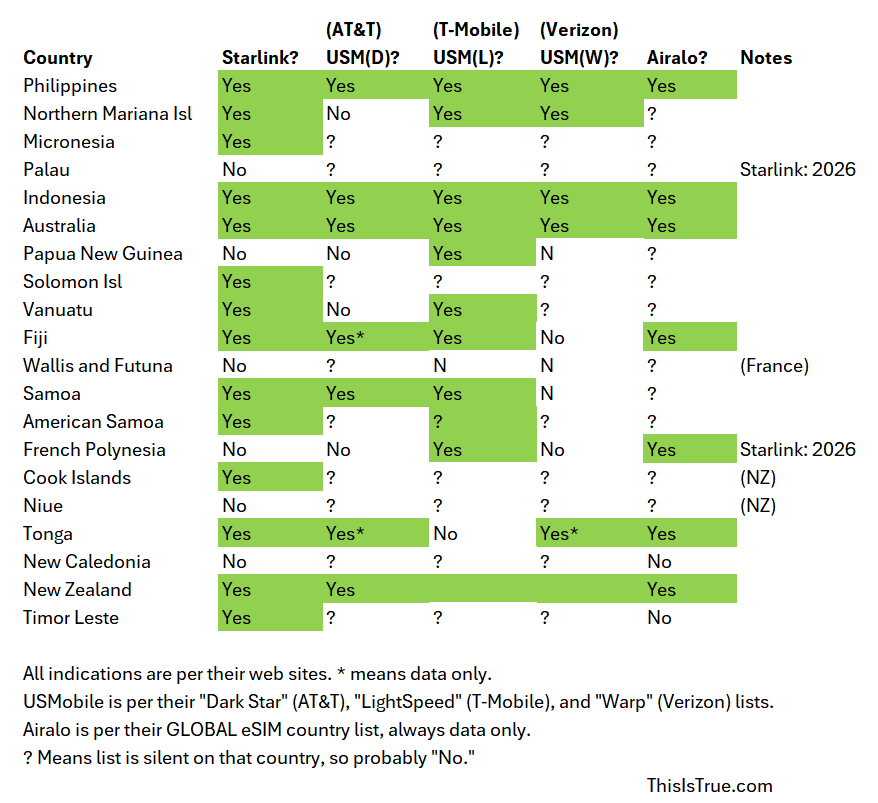I wrote about how the Internet aboard ship is “…Really?” back in April. Time for an update.
Another couple onboard has long had a Youtube channel, Geeks on Tour (“For travelers, cruisers, or anyone who wants to make better use of your phone. Our how-to videos can help you keep up.”)
When they started the channel way back in 2009 (more than 1,000 videos ago!), “on tour” meant full-time RVing. Then Jim (the male half of the duo), who is a long-time This is True reader, saw Kit and I were going to live on a cruise ship full time, and gasped “Woah!” (may not be an actual quote). He consulted Chris (his wife, the real brains behind the Geeks — no offense to Jim), did their due diligence, and decided to join us.
It took them a bit to sell their RV and other stuff, and once their house was under contract they joined us, doing the closing paperwork on the house from the ship. You can do that these days, yaknow!
Amusing side note: one of their RV buddies, Judy, saw them talking about the ship on the Geek Channel, and she decided to join the ship too.
Youtubers
Chris got the idea of sitting down with Kit and me to talk about a topic they thought their audience would be interested in: how good is the Internet here, really? Definitely a great topic! Their slant: can “digital nomads” who need decent Internet to do their jobs do OK full time on the ship?
So we sat down in front of their cabin in the Deck 8 “Observatory” lounge and had a chat, and here it is, courtesy of The Geeks.
A few notes: there’s some fun content before Kit and I appear, including the Geeks diving in Yap, Micronesia …with sharks. But if you want to jump ahead to where we appear, that’s at the 17-minute mark.
Part way through, they interrupt our conversation to explain a few things, and then go back to our conversation.
I give a shout-out to my fave online chef Sam the Cooking Guy at 40:45. (Warning: Sam cusses a lot, so don’t watch him if that offends you.)
It turned out Starlink did provide coverage in Palau — even though their web site makes it clear that it’s not going to be available there until 2026:

Research
One of the reasons I made the chart is to answer the question, “When should I buy an Airalo card?” Which is to say, when would we be in a country without Starlink and where my backup solution, my US Mobile-powered phone (discussed in this post), wouldn’t provide coverage? Plus, of course, “…and Airalo will?”
Since the Airalo, a data-only eSIM card, has a one-year lifespan whether you use it or not, I figured it was dumb to buy it before we really needed it. I expanded the chart to show all three US Mobile carriers not just as a proxy for the Big Three U.S. cell carriers, but also because so many other Residents signed up with US Mobile based on my recommendation, but with varying backbone carriers providing their service.
The chart shows we will have some challenges ahead, but when we are at sea between “no Internet” places, we’ll have coverage once we’re 12 miles away. When I put the chart on the internal chats, several other Digital Nomads among the residents wrote to say thanks. There’s that “community” thing again!
Bottom Line: Both we and The Geeks can work around the occasional outages, but we fully understand that not everyone can.
Bonus Video
Chris did an interview with me before they bought, on a “Try Before You Buy” trip to the ship in December/January. It’s 18 minutes:
Originally Published November 4, 2025 — Last Updated November 4, 2025

Sometimes not being able to connect to the Internet is a blessing! 😉
—
Hah! This is True. -rc
I was just in Australia on a Natural Habitat Adventures trip and knew it was impossible to connect with you during that, but it was interesting knowing you were in the same region. Internet was not always available. We went over a week with the only internet available at the central lodges, not in our accommodations. Given the locations, I didn’t miss it. Heck, most of our places didn’t have a TV.
—
Fun! I’m sure you had a great time. We do have a TV in our cabin. We don’t watch it except to briefly look at ship cameras, or messages. Not even the news, which is too much of a vast wasteland. -rc
You may have gone over this before, but if not, could you let us know how the ship’s staff communicates with everyone? Is there a newsletter? Is there some kind of instantaneous alert mode of communication?
—
The instantaneous alert mode is a PA system that broadcasts over the entire ship. There is also a private communications web site (and associated app) which isn’t all that great, but allows for detailed written material. -rc
Welcome to Australia. Although I gather it’s the Pacific after Cairns. I hope you enjoy Brisbane, although the cruise terminal is a long way out.
—
Thanks, mate! Apparently the Cairns dock is very close to the CBD. When there’s a long haul, there is often a shuttle bus. Worst case scenario is taxi service, which we have budgeted for. -rc
Interesting info in this post and the original about US Mobile (might even explain why we briefly saw Ting charge remittances at work back then). Can you easily have US Mobile change your service to one of their other underlying providers when needed for a particular country?
—
US Mobile says no, they can’t provision a phone on a new eSIM when outside the US, which is odd considering most eSIMs do not seem to have that problem. Hopefully as tech improves, they’ll get past that limitation. I’m not following your Ting comment; USM is considered a prepaid provider, so 911 surcharges come through on that side. [For others: I worked with Matt on the regional 911 Board in Colorado.] -rc
Thanks for the internet discussion. Especially enjoyed it because it reminded me just how far satellite communications has come in my lifetime.
I’m currently working on a memoir and looking at a lot of collected paperwork. Some from 1961, when I managed an Air Force site in Trinidad testing a passive (big balloon) satellite because there was a lot of doubt about whether it would ever be possible to build a reliable active satellite. Some from 1963 when I built a mobile satellite communications terminal that was eventually used for the first satellite link between Australia and the UK. You can see that one at the museum in Carnarvon if your ship goes there.
—
For others: Herb was one of my colleagues at the Jet Propulsion Laboratory. -rc
It’s highly amusing learning technology from your elders. I enjoy that aspect as a nearly 48 year old teenager. 🤣
As well as the idea the chip is just on giant prepaid cellphone waiting for a sim.
My question for Randy is what frequencies are these access points operating at? Dualband has great penetration for someone who’s in a stucco home.
They should be using different wifi frequencies just to avoid interference too but perhaps that part is mostly for urban settings.
—
Things aboard ship are VERY different from a house. Here, most walls (and decks and ceilings) are made of steel. Radio waves don’t penetrate metal well at all no matter what frequency. We need a crazy number of access points, and frequency coordination is a nightmare, which is why there are THREE full-time I.T. people to support it, plus contractors responsible for certain aspects. -rc